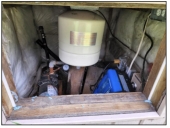Christopher Weeks wrote:I'm on my second house with a well (this one also in zone 3b) and in both cases, all that infrastructure (not the pump...that's down the well) was inside the house. Do you (or anyone) know what determines whether it's done the way I'm familiar with or the way depicted in these posts?
If there is a full basement, everything is usually in the basement of the house, since it will be heated anyway.
A house that only has a crawl space doesn't have a good place for a pressure tank, so it's put in an insulated well shed with options for electric heat.
On farms, where barns and outbuildings are often unheated, I have seen wells and pressure tanks inside an insulated, underground vault. In very cold weather an incandescent bulb or two sometimes provided extra heat to prevent pipes from freezing.







